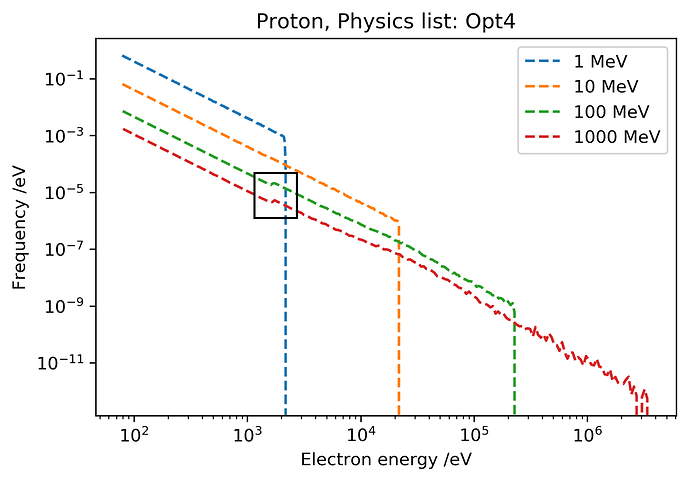Dear Geant4 users and developers,
I am using Geant4 (10.5.1) to simulate energy spectra of electrons produced by incident protons in water. So far, I only consider the first generation of electrons and score them in a 1 micrometer thick layer.
In the spectra I see a step at ~2 keV which I cannot explain by any physics process (see figure). Can anybody help me to find out where this step comes from? Here is what I found so far:-The peak is visible for 100 and 1000 MeV incident protons. It is not visible for 1 MeV protons and slightly showing up for 10 MeV protons.
-I see the step for several Physics lists I tried: G3EmStandardPhysics_Option1, G3EmStandardPhysics_Option3, G3EmStandardPhysics_Option4, G4EmPenelopePhysics and G4EmLivermorePhysics. I don’t see it with the G4EmDNAPhysics.
-The peak position does not change when changing the material; so I assume it is no physics effect.
-I only see the peaks for incident protons and helium. It is not visible for heavier ions.
-The peak size is increased especially for G3EmStandardPhysics_Option3. Maybe this is connected to the parameter finalRange which is reduced in Option3?
-The position of the peak is sensitive to the production cut which I set in the PhysicsList.cc. In the shown figure I set it to 78 eV - 1 GeV. If I increase the lower production limit the peak moves to higher electron energies.
-All electrons are created by the hIoni process, thus, it cannot be due to a switch between processes.
Is it possible that this peak is due to the condensed history approach in Geant4? This would explain why the peak is not visible for Geant4 DNA. How can I solve this issue?
I would be very grateful, if anyone could help me with this issue. I am thankful for every hint.
Best,
Tabea
